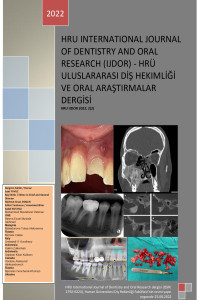Association of consanguineous marriages with severe early childhood caries: a pilot study
Association of consanguineous marriages with severe early childhood caries: a pilot study
Early childhood caries, consanguineous marriages, consanguinity, genetic dental syndromes.,
___
- 1. Ballantine JL, Carlson JC, Ferreira Zandoná AG, Agler C, Zeldin LP, Rozier RG, et al. Exploring the genomic basis of early childhood caries: a pilot study. Int J Paediatr Dent. 2018;28:217–25.
- 2. American Academy of Pediatric Dentistry. Policy on early childhood caries (ecc): Classifications, consequences, and preventive strategies. Pediatr Dent. 2016;38:52–4.
- 3. Çolak H, Dülgergil Ç, Dalli M, Hamidi MM. Early childhood caries update: A review of causes, diagnoses, and treatments. J Nat Sci Biol Med 2013;4:29–38.
- 4. American Academy of Pediatric Dentistry. Policy on early childhood caries (ECC): Classifications, consequences, and preventive strategies. Pediatr Dent. 2008;30:40–3.
- 5. Hurley E, Barrett MPJ, Kinirons M, Whelton H, Ryan CA, Stanton C, et al. Comparison of the salivary and dentinal microbiome of children with severe-early childhood caries to the salivary microbiome of caries-free children. BMC Oral Health. 2019;19:1–14.
- 6. Özen B, Van Strijp AJ, Özer L, Olmus H, Genc A, Cehreli SB. Evaluation of Possible Associated Factors for Early Childhood Caries and Severe Early Childhood Caries: A Multicenter Cross Sectional Survey. J Clin Pediatr Dent. 2016;40:118–23.
- 7. Anil S, Anand PS. Early childhood caries: Prevalence, risk factors, and prevention. Front Pediatr. 2017;5:157.
- 8. McAuliffe U, Kinirons M, Woods N, Harding M. A retrospective investigation of the oral health records of a cohort of preschool children who received extractions under general anaesthesia including cost analysis of treatment. J Ir Dent Assoc. 2017;63:38–44.
- 9. Slabsinskiene E, Milciuviene S, Narbutaite J, Vasiliauskiene I, Andruskeviciene V, Bendoraitiene EA, et al. Severe early childhood caries and behavioral risk factors among 3-year-old children in Lithuania. Medicina (Kaunas). 2010;46:135–41.
- 10. Khalil Elfaki N, Brair SL, Alsheikh MA. Association between hereditary factor and dental caries among school aged children in Najran – KSA. IOSR J Dent Med Sci. 2015;14:47–50.
- 11. Abbasoğlu Z, Tanboğa İ, Küchler EC, Deeley K, Weber M, Kaspar C, et al. Early childhood caries is associated with genetic variants in enamel formation and immune response genes. Caries Res. 2015;49:70–7.
- 12. Tadmouri GO, Nair P, Obeid T, Al Ali MT, Al Khaja N, Hamamy HA.. Consanguinity and reproductive health among Arabs. Reprod Health. 2009;6:17.
- 13. Calisir M. Oral and Periodontal Diseases in Consanguineous Marriages. In: Insights into Various Aspects of Oral Health. InTech; 2017.
- 14. World Health Organization. Oral health surveys: basic methods. 5th editio. Geneva: World Health Organization; 2013.
- 15. Ismail AI, Pitts NB, Tellez M. The International Caries Classification and Management System (ICCMSTM) An Example of a Caries Management Pathway. BMC Oral Health. 2015;15:S1–S9.
- 16. El Mouzan MI, Al Salloum AA, Al Herbish AS, Qurachi MM, Al Omar AA.. Consanguinity and major genetic disorders in Saudi children: A community-based cross-sectional study. Ann Saudi Med. 2008;28:169–73.
- 17. Rai NK, Tiwari T. Parental factors influencing the development of early childhood caries in developing nations: A systematic review. Front Public Heal. 2018;6:64.
- 18. Shimizu T, Deeley K, Briseño-Ruiz J, Faraco IM Jr, Poletta FA, Brancher JA, et al. Fine-mapping of 5q12.1-13.3 unveils new genetic contributors to caries. Caries Res. 2013;47:273–83.
- 19. Wang X, Shaffer JR, Zeng Z, Begum F, Vieira AR, Noel J, et al. Genome-wide association Scan of dental caries in the permanent dentition. BMC Oral Health. 2012;12:57.
- 20. Shimizu T, Ho B, Deeley K, Briseño-Ruiz J, Faraco IM Jr, Schupack BI, et al. Enamel Formation Genes Influence Enamel Microhardness Before and After Cariogenic Challenge. PLoS One. 2012;7:e45022.
- 21. Kaplan S, Pinar G, Kaplan B, Aslantekin F, Karabulut E, Ayar B, et al. The prevalence of consanguineous marriages and affecting factors in Turkey: A national survey. J Biosoc Sci. 2016;48:616–30.
- 22. Bener A, Hussain R. Consanguineous unions and child health in the State of Qatar. Paediatr Perinat Epidemiol. 2006;20:372–378.
- 23. Ceyhan D, Kirzioglu Z, Emek T. A long-term clinical study on individuals with amelogenesis imperfecta. Niger J Clin Pract. 2019;22:1157–62.
- 24. Paula LM, Melo NS, Silva Guerra EN, Mestrinho DH, Acevedo AC. Case report of a rare syndrome associating amelogenesis imperfecta and nephrocalcinosis in a consanguineous family. Arch Oral Biol. 2005;50:237–42.
- Başlangıç: 2021
- Yayıncı: Harran Üniversitesi
Endokron Restorasyonlar ve Endokron Restorasyonlarda Kullanilan Materyaller
Esengül SEZGİN, Yakup KANTACI, Burcu ÜSTÜN
Oculo-Dento-Digital Dysplasia (Oddd), Report of a Case
Pamela ARMİ, Roberta D’AVENİA, Cristina VİLLANACCİ, Francisco Cammarata SCALİSİ, Michele CALLEA
Sabit Protetik Restorasyonlarda Kullanilan Interokluzal Kayit Materyalleri ve Teknikleri; Derleme
Mehmet Emin DOĞAN, Eda Didem YALÇIN
An In Vitro Microleakage Evaluation of a New Cold Flowable Gutta-Percha Based Sealer
Abdurrahman Can ÖNALAN, Faruk ÖZTEKİN
Association of consanguineous marriages with severe early childhood caries: a pilot study
Ahmet ARAS, Mehmet Sinan DOĞAN, Şemsettin YILDIZ, Muhammed DEMİR
Çocuklarda Endodontik Enfeksiyonlara Bağlı Antibiyotik Kullanımı
Gizem KARAGÖZ DOĞAN, İsmet Rezani TOPTANCI
Muhammed DEMİR, Fatih TULUMBACI
Teacher’s Preferences to Receive Oral Health Information Using Internet
Peter ANDREAS, Mutiara AMANDA, Iwany Amalliah BADRUDDİN, Febriana SETİAWATİ, Diah MAHARANİ
